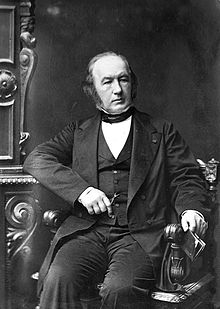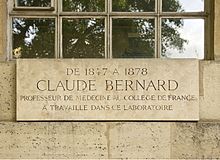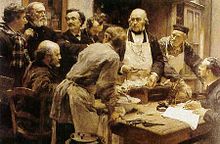Claude Bernard (medical doctor)
Claude Bernard (born July 12, 1813 in Saint-Julien in the Rhône department , † February 10, 1878 in Paris ) was a French doctor, pharmacist and experimental physiologist.
meaning
Bernard discovered the role of the pancreas in the digestion of fats and the role of the liver in the internal secretion of glucose in the blood, thus uncovering the cause of diabetes mellitus . He also clarified as carbon monoxide , the breathing is blocked, and is considered the founder of experimental toxicology , saw the organism as a self-regulating system and created basic biochemistry and modern scientific method in medicine.
Life
Claude Bernard was born in Saint Julien (more precisely in the town of Chatenay) in Beaujolais as the son of Pierre François Bernard († 1847), a winemaker and teacher, and Jeanne Saulnier († 1867). He was the eldest son of this family of four. The village pastor taught him the basics of writing and reading.
Bernard first attended the Jesuit school in Villefranche-sur-Saône , then he became a student at the Collège de Thoissey . At the age of eighteen he had to leave high school for financial reasons. To support his father, he took a job as an apprentice pharmacist. From 1832 to 1833 he worked as an apprentice pharmacist in Vaise, a suburb of Lyon. In 1834 he traveled to Paris. Before studying medicine, the now twenty-year-old occupied himself with writing. So he wrote u. a. the play La Rose du Rhône , which was performed in Lyon . Another work, the (historical) drama Arthur de Bretagne , he presented to the literary critic Saint-Marc Girardin . However, he was not particularly affected by the play and advised C. Bernard not to make writing his main occupation.
In 1834 Bernard moved to Paris. Here he obtained the Baccalauréat and enrolled in the medical faculty of the University of Paris. Bernard received his license to practice medicine in 1843 . The subject of his dissertation published in 1844 at the Paris Faculty of Medicine was Des matières colorantes chez l'homme . In 1848 he became François Magendie's assistant at the Hôtel-Dieu in Paris. With his work Recherches sur une nouvelle fonction du foie considéré comme organe producteur de matière sucrée chez l'homme et les animaux , he received his doctorate in zoology in 1853 . In 1854 a chair for general physiology was created for Bernard at the Sorbonne . In 1855 he succeeded Magendie at the Collège de France .
On May 7, 1845, Bernard married Marie-Françoise Martin . Her dowry funded some of his research. The couple had two daughters, Jeanne-Antoinette-Henriette (1847–1923) and Marie-Louise-Alphonsine Bernard (1850–1922) and two sons, Louis-Henri and Claude-Henri-François Bernard, who were aged 2 and 15 Months passed away. During the course of their marriage, Marie-Françoise developed an aversion to animal experiments, which her husband regularly relocated from the Collège de France to his private laboratory. She tried several times to sabotage the attempts and asked the animal welfare association to sue her husband. In 1869 Bernard entered into a friendly relationship with Madame Marie Raffalovich (1832-1921), which deepened after his divorce on August 22, 1870. She was the wife of a Parisian banker and became a loyal friend in Bernard's last years.
When Claude Bernard died in 1878, he was buried in public. He is buried in the Père Lachaise cemetery in Paris. Bernard Island and Bernard Rocks in Antarctica are named in his honor .
Scientific work
The aim of the scientific work of Claude Bernard was - as he himself explained - to establish the use of the scientific method in medicine. He refuted many traditional doctrines, took nothing for granted and relied on animal experiments . Unlike most of his contemporaries, he insisted that all living beings are subject to the same laws of nature as inanimate matter. Bernard explained that facts are the foundation of science and that analogy thinking and a priori inferences are inadmissible for an exact science. The starting point for the research is observations. Explanatory hypotheses would have to be checked for accuracy in the experiment . Under the given experimental conditions, the same causes would also have the same effects, there was a causal relationship. In his opinion, the physiological laboratory was the place of scientific research and knowledge. On the other hand, he considered the hospital or the sick bay to be observation fields. The clinic is only the vestibule of scientific medicine, the laboratory rather the “true sanctuary” of medical science. Only then can pathological and non-pathological elements be distinguished or, at best, explained by means of experimental analysis.
He was the first to describe the importance of the milieu intérieur for maintaining life and was thus one of the first protagonists of homeostasis . He developed this concept and the term Fixité du milieu intérieur , according to which the internal fluids are essential for the life of animals and their survival depends on whether this homeostasis can be maintained.
“Je crois avoir le premier insisté sur cette idée qu'il ya pour l'animal réellement deux milieux: un milieu extérieur dans lequel est placé l'organisme, et un milieu intérieur dans lequel vivent les éléments des tissus. L'existence de l'être se passe, non pas dans le milieu extérieur, air atmosphere pour l'être aérien, eau douce ou salée pour les animaux aquatiques, mais dans le milieu liquide intérieur formé par le liquid organique circulant qui entoure et où baignent tous les éléments anatomiques des tissus; c'est la lymphe ou le plasma, la partie liquide du sang, qui, chez les animaux supérieurs, pénètrent les tissus et constituent l'ensemble de tous les liquides interstitiels, expression de toutes les nutritions locales, source et confluent de tous les échanges élémentaires "
“I think I was the first to emphasize the idea that there are actually two environments for animals: an external environment in which the organism is located and an internal environment in which the components of living tissue are located. The actual existence of being does not happen in the external environment - atmospheric air, fresh or salt water for the aquatic animals - but within the liquid medium through circulating organic liquid. It surrounds or envelops all anatomical elements of the tissues. It is the lymph or plasma fluid, the fluid components of the blood in the higher animals, they penetrate the tissues and form all interstitial fluids. They are the expression of all local nutrition, the source and outlet of all elementary exchange "
In the years 1848 to 1849 he discovered the function of the pancreatic secretion for the digestion of fat from the pancreas . In 1853 he obtained a doctorate in zoology with a major study on the metabolism of the liver and its importance in digestive processes: Recherches sur une nouvelle fonction du foie considéré comme organe producteur de matière sucré chez l'homme et les animaux . He discovered glycogen .
In 1852, Bernard described that after severing the cervical sympathetic ganglia in the mammal, warming and increased blood flow occurred in the entire head. In mammals there are three cervical ganglions: the upper ( ganglion cervicale superius ), the middle ( ganglion cervicale medium ), which is inconsistent, and the lower cervical ganglion ( ganglion cervicale inferius ).
In 1865, C. Bernard's most extraordinary book on the philosophy and fundamental understanding of experimental medicine was published. Bernard is also the scientist who founded the discipline of experimental physiology with his curare experiments on frogs . In 1856 he was able to show that curare blocks the conduction functions of the neuro-muscular synapses .
In 1854 he was elected to the Académie des Sciences . In 1859 he became a foreign member of the Bavarian Academy of Sciences . From 1860 he was a corresponding member of the Prussian Academy of Sciences and the Russian Academy of Sciences . In 1868 he was accepted into the Académie française and in the same year into the Royal Swedish Academy of Sciences . In 1870 he became an Honorary Fellow of the Royal Society of Edinburgh . In 1876 he received the Copley Medal of the Royal Society , of which he was an external member since 1864. The American historian of science I. Bernard Cohen from Harvard University called Claude Bernard “one of the greatest scientists”.
Probably the best-known quote from Claude Bernard, with which he draws the conclusion of his 40 years of research, is:
"Le germe n'est rien, le terrain est tout!"
"The germ is nothing, the milieu is everything!"
Works (selection)
- You suc gastrique et de son rôle dans la nutrition. Paris 1843.
- Précis iconographique de médecine opératoire et d'anatomie chirurgicale. Paris 1846.
- Research on une nouvelle fonction du foie considéré comme organe producteur de matière sucré chez l'homme et les animaux . Martinet, Paris 1853:
- Leçons de physiologie expérimentale appliquée à la médecine, faites au collége de France . J.-B. Baillière et fils, Paris 1855–1856.
- Leçons sur les effets des substances toxiques et médicamenteuses. Paris 1857.
- Introduction to the étude de la medical experimentale . Paris 1865 :; German edition: Introduction to the study of experimental medicine , Leipzig 1961 ( French text from Project Gutenberg )
- Leçons de pathologie expérimentale et lecons sur les propriétés de la moelle épinière . J.-B. Baillière et fils, Paris 1872
- Leçons sur les phénomènes de la vie communs aux animaux et aux végétaux . 2 volumes. J.-B. Baillière et fils, Paris 1878–1879
literature
- Frederic L. Holmes : Claude Bernard and Animal Chemistry , Harvard University Press, 1974.
- R. Villey, F. Brunet, G. Valette and others: Histoire de la Médicine, de la Pharmacie, de l'Art Dentaire Vétérinaire. Albin Michel-Laffont-Tchou, Paris 1978.
- Hubert Bretschneider: The dispute about vivisection in the 19th century. Stuttgart 1962.
- Gerhard Buchholz: The medical theory of Claude Bernards. Murken-Altrogge, Herzogenrath 1985, ISBN 3-921801-24-9 .
- AI Boullerne: Neurophysiology to Neuroanatomy: the transition from Claude Bernard to Louis Antoine Ranvier. (PDF 1009.04 KB). In: Archives Italiennes de Biologie. 149 (Suppl.), 2011, pp. 38-46.
- Barbara I. Tshisuaka: Bernard, Claude. In: Werner E. Gerabek , Bernhard D. Haage, Gundolf Keil , Wolfgang Wegner (eds.): Enzyklopädie Medizingeschichte. de Gruyter, Berlin / New York 2005, ISBN 3-11-015714-4 , p. 168 f.
Web links
- Literature by and about Claude Bernard in the catalog of the German National Library
- Short biography and list of works of the Académie française (French)
- Claude Bernard - Images de la vie de Bernard
- Short biography and references to digital sources in the Virtual Laboratory of the Max Planck Institute for the History of Science (English)
- DS Goldstein, IJ Kopin: Evolution of concepts of stress. In: Stress. Volume 10, No. 2, Jun 2007, pp. 109-120. PMID 17514579 . Clinical Neurocardiology Section, National Institute of Neurological Disorders and Stroke, Bethesda MD
- JT Fitzsimons: The experimental notebooks of Claude Bernard [proceedings]. In: The Journal of Physiology. Volume 263, Number 1, December 1976, pp. 37P-41P, ISSN 0022-3751 . PMID 796426 . PMC 1307675 (free full text).
Individual evidence
- ↑ The birthplace and today's museum
- ↑ Nikolaus Mani : The discovery of the glycogen by Claude Bernard. ( Memento of March 10, 2016 in the Internet Archive ) (PDF; 2.1 MB). In: Journal of Clinical Chemistry. Organ of the German Society for Clinical Chemistry. Issue 4, August 1964, pp. 97-128.
- ↑ Rudolf Kötter: Claude Bernard and the logic of the experiment in modern physiology. Paderborn 2008. (PDF)
- ^ Claude Bernard: Des matières colorantes chez l'homme . Laté, 1844.
- ↑ Comprehensive biography of Marie-Aymée Marduel in French with pictures (PDF; 7.9 MB). 2006.
- ↑ Pictures of the daughters
- ↑ Hans Ruesch: Naked ruler. The undressing of medical science. Edition Hirthammer Tier- und Naturschutz, Munich 1978, ISBN 3-921288-44-4 , p. 221.
- ^ Robert Clarke: Claude Bernard et le medecine experimentale. Editions Seghers, Paris 1961.
- ^ Papers of and relating to Marc André Raffalovich
- ↑ CLAUDE BERNARD - Images de la vie de Bernard
- ^ C. Bernard: Leçons sur les phénomènes de la vie communs aux animaux et aux végétaux.
- ^ Charles E. Gross: Claude Bernard and the internal environment. (PDF; 1.2 MB). In: The Neuroscientist. Volume 4, No. 5, 1998, pp. 380-385.
- ^ FG Young: Claude Bernard and the Discovery of Glycogen. In: Br Med J. 1 (5033), June 22, 1957, pp. 1431–1437, PMC 1973429 (free full text)
- ↑ First mention of the term glycogen ; handwritten by C. Bernard easd.org ( Memento from September 22, 2010 in the Internet Archive )
- ↑ Les membres du passé dont le nom commence par B. Académie des sciences, accessed on September 14, 2019 (French).
- ↑ Member entry of Claude Bernard at the Bavarian Academy of Sciences , accessed on January 4, 2017.
- ^ Members of the previous academies. Claude Bernard. Berlin-Brandenburg Academy of Sciences and Humanities , accessed on February 20, 2015 .
- ^ Foreign members of the Russian Academy of Sciences since 1724: Bernard, Claude. Russian Academy of Sciences, accessed September 14, 2019 (Russian).
- ^ Biographical Index: Former RSE Fellows 1783–2002. Royal Society of Edinburgh, accessed October 8, 2019 .
- ^ Entry on Bernard; Claude (1813-1878) in the Archives of the Royal Society , London
- ^ Foreword to Cohen's Dover edition (1957) of “Claude Bernard's classic on scientific method”. An Introduction to the Study of Experimental Medicine (originally published in 1865).
| personal data | |
|---|---|
| SURNAME | Bernard, Claude |
| BRIEF DESCRIPTION | French physiologist |
| DATE OF BIRTH | July 12, 1813 |
| PLACE OF BIRTH | Saint-Julien (Rhône) |
| DATE OF DEATH | February 10, 1878 |
| Place of death | Paris |



